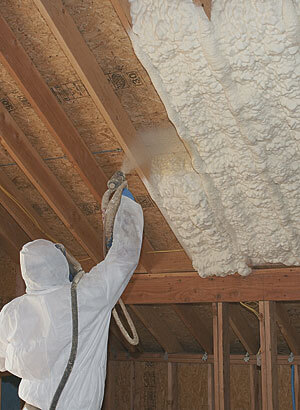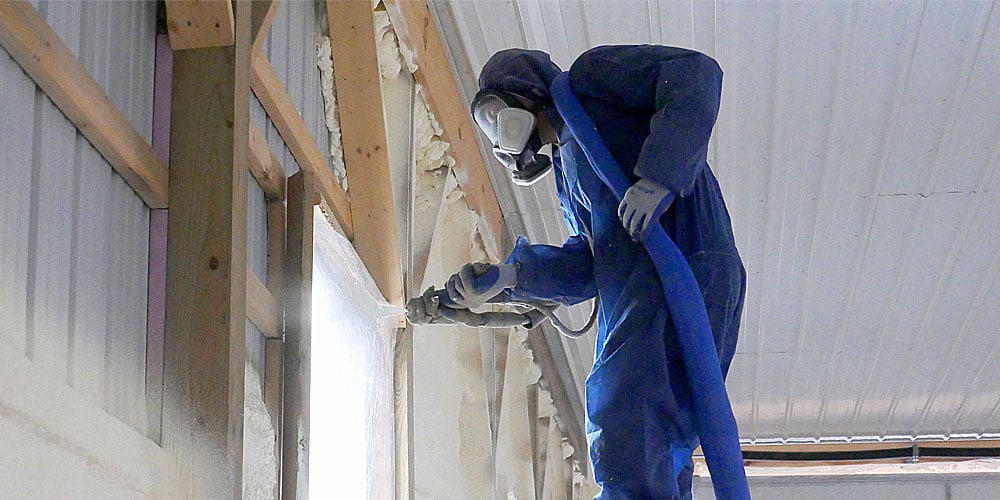The Process of Using Spray Foam: What You Need to Know
The Process of Using Spray Foam: What You Need to Know
Blog Article
Spray Foam: The Ultimate Solution for Air Sealing and Insulation
Spray foam insulation has arised as a leading remedy for efficient air sealing and thermal insulation, using a special mix of buildings that set it aside from conventional techniques. Its capability to broaden and load voids makes it especially effective in stopping air leakage, which can considerably impact energy effectiveness. Comprehending the complete range of its benefits, installation processes, and contrasts with various other insulation kinds is essential for making educated decisions. As we explore these elements, the effects for both new constructions and retrofits end up being increasingly significant. What elements should influence your selection?
What Is Spray Foam?
Spray foam is a versatile insulation material that combines the principles of air sealing and thermal resistance to improve energy efficiency in structures. Made up primarily of polyurethane or other comparable substances, spray foam is used as a fluid that increases upon call with surfaces, creating a strong, constant layer of insulation. This unique home allows it to load gaps, splits, and voids that typical insulation materials might ignore, giving a remarkable air seal.
There are two major sorts of spray foam: open-cell and closed-cell. Open-cell spray foam is lighter and extra adaptable, supplying exceptional sound absorption and a reduced R-value per inch - Spray Foam. On the other hand, closed-cell spray foam is denser, providing a higher R-value, dampness resistance, and included architectural stability to constructing elements
The application procedure commonly involves customized devices, making certain a seamless application that adheres to numerous substrates, including steel, concrete, and wood. This versatility makes spray foam appropriate for both brand-new building and constructions and retrofitting existing frameworks. Its capacity to develop an impermeable barrier significantly contributes to lowering power consumption and enhancing interior air top quality, therefore making it a recommended selection among contractors and home owners alike.
Advantages of Spray Foam Insulation
One of the most considerable benefits of spray foam insulation is its exceptional capacity to create a constant air barrier, which properly decreases power loss. Unlike typical insulation materials, spray foam broadens to fill up gaps and cracks, making sure that air leak is significantly reduced. This particular not only enhances energy effectiveness but also brings about decrease utility expenses gradually.
Furthermore, spray foam insulation gives superior thermal resistance, adding to a more stable interior environment. Its high R-value per inch permits reliable insulation in restricted spaces, making it ideal for attics, wall surfaces, and crawl rooms. Furthermore, the moisture-resistant homes of spray foam aid stop mold and mold development, promoting much healthier living problems.
One more critical advantage of spray foam insulation is its sound-dampening qualities (Spray Foam). It efficiently decreases sound transmission between areas, developing a quieter and much more comfortable home atmosphere. The durability of spray foam likewise sticks out, as it does not sag or resolve with time, preserving its performance throughout its lifespan
How Spray Foam Functions
Recognizing just how spray foam insulation functions is crucial for valuing its performance in air check this securing and thermal resistance. Spray foam insulation includes 2 primary parts: isocyanate and polyol material. When these components are blended, they go through a chain reaction that causes the product to increase quickly, creating a dense foam that fills up voids, dental caries, and fractures.
As the foam expands, it sticks to surfaces, developing an impermeable seal that considerably reduces air infiltration. This characteristic makes spray foam insulation very reliable at stopping drafts and moisture infiltration, which can bring about power loss and damages over time. In addition, the closed-cell variant of spray foam provides remarkable thermal resistance because of its rigid framework, efficiently decreasing heat transfer.
The distinct homes of spray foam allow it to comply with irregular surfaces, guaranteeing extensive coverage and a seamless barrier. As a result, spray foam insulation not just boosts power performance but additionally adds to enhanced indoor air quality by decreasing the build-up of allergens and pollutants. Inevitably, recognizing the technicians behind spray foam underscores its role as a remarkable choice for insulation and air sealing in both commercial and household applications.
Setup Refine Summary

Before setup, the room should be properly cleaned and prepped, making certain that surface areas are free from dirt, debris, and moisture. Because pollutants can compromise adhesion and general performance, this action is essential. When the area is prepared, the application includes mixing the 2 parts of the spray foam, which increases upon get in touch with and fills up gaps efficiently.
Educated specialists ought to perform the setup, utilizing specialized equipment to guarantee consistent protection and optimum density. Security precautions, including putting on safety equipment and making sure proper air flow, are critical during this procedure. After application, the foam typically treatments swiftly, forming a solid barrier that boosts power performance.
Comparing Spray Foam to Traditional Insulation
When examining insulation alternatives, spray foam insulation stands out in contrast to standard materials such as fiberglass and cellulose. Unlike fiberglass and cellulose, which can enable air infiltration, spray foam increases upon application, filling up crevices and voids to develop a closed seal.
Additionally, spray foam gives a higher R-value per inch than standard insulation kinds, offering more reliable thermal resistance in a thinner profile. This characteristic is particularly beneficial precede with minimal tooth cavity depth. In addition, spray foam is immune to moisture and mold and mildew growth, which can be a considerable interest in cellulose and fiberglass, specifically in moist environments.
Nonetheless, spray foam insulation typically brings a greater ahead of time price than its typical equivalents. Homeowners have to consider this initial investment versus lasting energy savings and performance benefits. Ultimately, while both insulation types offer their function, spray foam becomes an advanced service for contemporary insulation needs, particularly in regards to air securing and thermal efficiency.

Final Thought
In summary, spray foam insulation represents a highly efficient published here solution for attaining optimal air sealing and thermal resistance. Its special residential properties, including wetness resistance and audio dampening, make it appropriate for numerous applications in both new building and constructions and retrofitting tasks (Spray Foam). Although the preliminary expenses may be greater contrasted to standard insulation products, the long-lasting benefits, such as substantial energy savings and boosted interior air quality, warrant the investment and underscore its worth in contemporary building practices.
Spray foam insulation has actually emerged as a leading remedy for efficient air securing and thermal insulation, using a special mix of buildings that establish it apart from traditional approaches.Spray foam is a versatile insulation material that incorporates the principles of air securing and thermal resistance to enhance energy performance in buildings.When reviewing insulation options, spray foam insulation stands out in contrast to traditional materials such as fiberglass and cellulose. Inevitably, while both insulation types serve their objective, spray foam emerges as a much more innovative service for modern-day insulation needs, especially in terms of air securing and thermal efficiency.
In recap, spray foam insulation check this site out stands for a highly efficient solution for achieving ideal air securing and thermal resistance.
Report this page